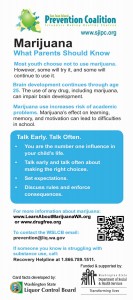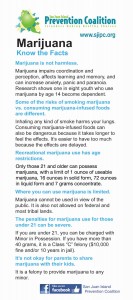With the passing of I-502 (in Washington State), Legalization of Marijuana use for adults 21 and over, the SJIPC would like to ask your help in keeping our youth drug-free. This page will be used to share up-to-date science and facts about the harmful effects marijuana has on the developing brain.
Did you know? The science shows that brain development continues through age 25. Ever wonder why car rental companies don’t rent cars to youth under 25 years of age, without a hefty fee? “According to recent findings, the human brain does not reach full maturity until at least the mid-20s. (See J. Giedd in References.) The specific changes that follow young adulthood are not yet well studied, but it is known that they involve increased myelination and continued adding and pruning of neurons. As a number of researchers have put it, “the rental car companies have it right.” The brain isn’t fully mature at 16, when we are allowed to drive, or at 18, when we are allowed to vote, or at 21, when we are allowed to drink, but closer to 25, when we are allowed to rent a car.” MIT, Young Adult Development Project.
SJIPC Letter to Parents on Marijuana
PDF Files:
Liquor Control Board’s Information Card, recently mailed out to San Juan Island School District mailing list, a partner of the SJIPC, we thank you for your support of raising healthy youth… Links below may be printed out.
Know the Facts – Marijuana and Underage Use
(Separate Panels: MJ-know-the-facts-ltblue-front and MJ-know-the-facts-ltblue-back)
Prevention
A Parent’s Guide to Preventing Underage Marijuana Use (2014)
Created by Seattle Children’s Hospital and Foundation to assist parents with the issue of marijuana use now that recreational use is legal for adults in Washington. Provides information about marijuana use and guidelines on how to talk to teenagers about the risks of use.
Underage Marijuana Use Prevention Toolkit (2014)
From Washington State. Example of a useful website that can provide a variety of prevention resources to coalitions, communities, or organizations.
Strategies/Interventions for Reducing Marijuana Use (2014)
Center for the Application of Prevention Technologies – summarizes the evidence found in literature for strategies that may affect the initiation, escalation and consequences of marijuana use.
Preventing Youth Marijuana: An Annotated Bibliography (CAPT Decision Support Tools) (2014)
This annotated bibliography was developed for use by substance abuse prevention practitioners charged with providing guidance or technical assistance to grantee communities seeking to address youth marijuana use in their communities.
Strategies and Interventions to Prevent Youth Marijuana Use: An At-a-Glance Resource Tool (CAPT Decision Support Tools) (2014)
This document provides brief summaries of substance abuse prevention strategies and associated interventions that have been evaluated to determine their effects on marijuana outcomes for youth populations; and should be considered a resource for state- and community prevention practitioners seeking information on interventions to reduce marijuana use among youth.
Risk and Protective Factors Associated with Youth Marijuana Use (CAPT Decision Support Tools) (2014)
Understanding those factors associated with marijuana abuse helps us know how to assess, plan for, and select interventions designed to address these factors. This document provides a summary of research findings on factors associated with marijuana use among youth. These factors have been organized according to the socio-ecological model, a multi-level framework that allows us to consider the different contexts in which shared risk and protective factors exist.












